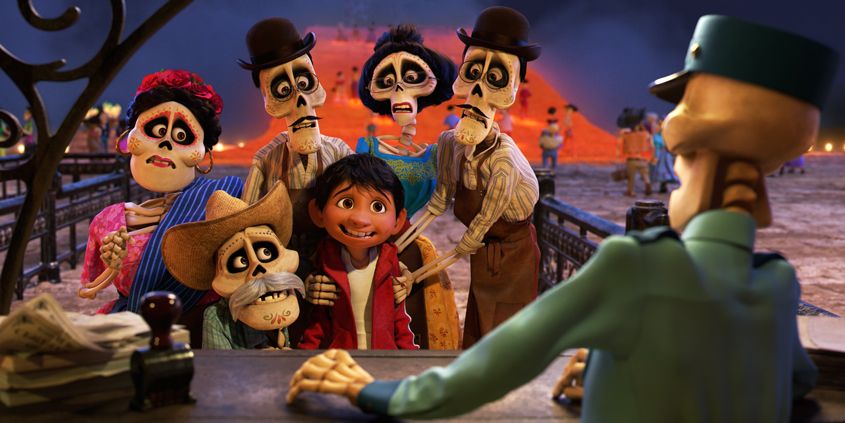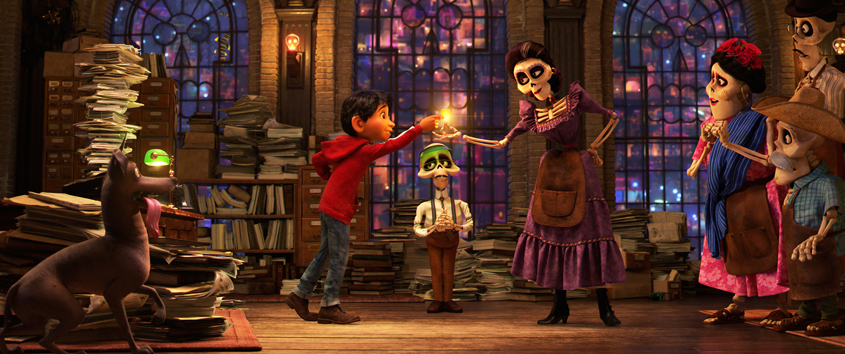
COCOpyright and the value of moral rights
By Javier André Murillo Chávez, Professor, Pontifical Catholic University of Peru, Lima, Peru
“Those who don’t cry after seeing Coco do not have a soul,” claims a popular Internet image that went viral shortly after the release of the acclaimed Disney film, Coco, in late 2017.
Intellectual property (IP) lawyers and academics have two reasons to shed a tear when they see this masterpiece of the seventh art. First, because it is a heart-warming story that promotes family values, and second, because the film is about music, lyrics, songs, mariachis, and the role that copyright plays in protecting them and the interests of creators.
Disney’s Coco recounts the story of Miguel Rivera, a young boy who is drawn to music, but is forbidden by his family to follow his dreams because of the hardship brought on them when Miguel’s great-grandfather seemingly abandoned them for a life on the stage. In his efforts to realize his dreams, Miguel finds himself among his ancestors in the spirit world of the afterlife. Copyright and moral rights, in particular, lie at the heart of the story. Only when Miguel discovers what really happened to his great-grandfather – he was murdered by his best friend, who stole his songs and rose to fame singing them – did Miguel’s family allow him to become a musician.

Unwrapping moral rights
At the international level, the Berne Convention for the Protection of Literary and Artistic Works (Article 6bis) requires its members to grant authors the following rights:
- the right to claim authorship of a work you have created (also referred to as the right of attribution); and
- the right to object to any distortion or modification of your work that may be prejudicial to your honor or reputation (also referred to as the right of integrity).
Moral rights are conferred on individual authors. In many national laws, these rights cannot be transferred or waived; authors retain them even after they have transferred their economic rights.
In the laws of some countries, the moral rights conferred in national law go beyond the international standard set by the Berne Convention. Although these may differ from one country to another, they may also include the right:
- to decide whether or not your work may be disclosed or released to the public, and when and how such disclosure takes place;
- to withdraw all commercially-available copies of a previously published work that contains intellectual or moral opinions you no longer hold (with appropriate financial compensation to any third parties, of course); and
- to have access to the original work in the case of one-off pieces, such as a painting or sculpture.
The weight given to moral rights in countries with civil law traditions far exceeds that conferred by the common law systems of the United Kingdom and the United States, where economic rights have far greater importance. In the United States, for example, until the adoption of the Visual Artists Rights Act (VARA) in 1990, artists in that country had little, if any, legal means of protecting the integrity of their work. And, while VARA has improved the situation, the Act still only applies to visual artists and is quite limited in its scope.

Despite these differences in civil and common law systems, economic rights and moral rights are two sides of the same copyright coin. Economic rights are, without question, the engine of the copyright system; they ensure that the author is financially remunerated and can earn a living from her or his work. As such, economic rights are an incentive for creators to invest their time, energy and talent in enriching our cultural heritage. But moral rights provide the basis for economic rights to function. Imagine a copyright system that allows artists to compose songs that audiences love, but which are appropriated by third parties who falsely claim authorship; or in the art world, a masterpiece to which third parties add doodles without the artist’s permission. Beyond the injustice of not being recognized as the author of something you have created, where is the incentive to create if others can simply free-ride on and benefit from your work, leaving you with nothing?
Moral rights and Hector Rivera’s legacy
As Hector Rivera’s story unfolds, the audience is drawn into a powerful tale about why moral rights are so important, and – as expressed through the Day of the Dead celebrations, when family and friends gather to remember those who have died – their perpetual nature. In many legal systems, moral rights protect a creator’s work in life and after their death.
Hector’s story highlights what can happen when a creator’s moral rights are infringed and how a creator’s reputation can be ruined when an imposter takes his or her place. In Coco, Hector, the rightful composer and singer, was reduced to a penniless vagrant, while his usurper, the “great” Ernesto de la Cruz, is – initially, at least - portrayed as the most famous Mexican mariachi composer and performer in history.
Some may dismiss moral rights because they do not generate any income, at least directly. But for a creator, moral rights are critically important, in life and in death, because they safeguard their association with their work, which is the embodiment of their creative talent. Without moral rights, and the recognition and protection they afford, how can authors build their reputation and prevent others from modifying them without permission? More importantly, how can creators secure remuneration for their works without the guarantees that moral rights offer?

When Ernesto De la Cruz murdered Hector Rivera in the film, he did not just end his life and take him away from his family forever. By stealing his lyrics and his songs, he also killed his memory and his legacy. This is powerfully illustrated by Hector’s song Remember Me, which he had composed for his daughter and which encapsulates the originality of his work. Because of Ernesto’s actions, Miguel’s family came to hate music, believing it was the source of their hardship. But as the story reveals, their belief that Hector had abandoned them turned on a lie – plagiarism in the extreme.
As mentioned above, moral rights also play an important role following a creator’s death, as they enable a creator’s heirs to protect his or her memory. By portraying a world in which dead people are unable to defend their interests, the film deftly highlights the importance of legal rules and procedures to protect the privacy, authorship, integrity, access and dignity of creators’ original works during their lives.
Imagine how many stories like Hector’s actually play out in the real world. Plagiarism, as the principal enemy of the moral right of authorship, is one of the most difficult types of infringement to detect. Why? Because authors often have a poor knowledge of copyright law, and because infringers always try to hide their underhanded behavior. These two factors make it difficult for copyright lawyers to prove that infringement has actually occurred.
One could also draw parallels between the moral rights issues traced in Coco and the growing number of ghost writers we see today. Ghost writers create a work on behalf of a third party in return for money, on the understanding that their contribution to that work is not publicly recognized. The term “ghost” can now also be applied to lyricists, scriptwriters, painters, sculptors and many other creators. Ghost writers and creators are widespread within common law systems. However, in civil law systems, they are not recognized, given the inalienable nature of moral rights, which cannot be surrendered or transferred.

Educating children about moral rights
Hector’s story is a powerful representation of the real damage and hardship that can arise when moral rights are infringed. There are at least three moving twists in the film: the revelation that Miguel’s great-great grandfather was in fact Hector Rivera, an accomplished Mariachi composer and singer; the discovery that Coco is Hector’s daughter; and Miguel’s interpretation of Remember Me for his grandmother, mamá Coco. After that last moving scene, the audience is still left wondering what will happen to the dastardly Ernesto de la Cruz. But thankfully, the film ends on a happy note from a legal perspective. First, we see Ernesto’s derelict tomb dressed in a banner bearing the word “forgotten,” shrouded in spider webs and dust. Second, a tourist guide explains how Miguel, with the help of the letters mamá Coco had received from her father, had unmasked Ernesto’s fraudulent acts and restored Hector Rivera’s reputation to its rightful place.
Of course, Coco serves up the required happy Disney ending we all expect, but it also sends a powerful message to children about the importance of moral rights and the consequences of not respecting them. Filmmakers often touch on the economic importance of IP rights in their movies, but moral rights typically remain in the shadows. Coco breaks that mold.

The children who see films like Coco have minds like sponges; they absorb everything. Movies and TV shows are very powerful mediums by which to explain moral values to children. In an industry plagued with piracy and plagiarism, movies are a smart way to improve understanding about the role and importance of intellectual property (IP) rights like copyright, and to impress upon children the impact that infringement can have on creators and their families.
Arguably, the damage caused by infringing moral rights is not comparable to infringement of economic rights, but Coco demonstrates the close interplay between each. The fact that Hector’s legacy was lost because his moral rights had been infringed meant that his family did not receive their rightful royalties from the songs Hector had composed and which Ernesto had stolen. Here we see in practical terms that economic rights cannot function effectively without moral rights.
These powerful messages will be absorbed by the thousands of families who see the film. Chances are, they are going to really dislike Ernesto De la Cruz for his actions and will embrace the idea that stealing an artist’s songs and lyrics can bring misfortune and penury to creators and their families. By airing these issues in children’s films, filmmakers create opportunities to support the emergence of a new generation of copyright-aware citizens. That is the value of exposing audiences to films like Coco.
There is a hope in every IP lawyer and academic – including those who have taken their children to see Coco – that one day when our sons and daughters express a wish to become an artist, composer or writer, we are not panic stricken, but can breathe calmly, secure in the belief that their work will be respected and protected, and can support them and say, “What a great idea!”
The WIPO Magazine is intended to help broaden public understanding of intellectual property and of WIPO’s work, and is not an official document of WIPO. The designations employed and the presentation of material throughout this publication do not imply the expression of any opinion whatsoever on the part of WIPO concerning the legal status of any country, territory or area or of its authorities, or concerning the delimitation of its frontiers or boundaries. This publication is not intended to reflect the views of the Member States or the WIPO Secretariat. The mention of specific companies or products of manufacturers does not imply that they are endorsed or recommended by WIPO in preference to others of a similar nature that are not mentioned.